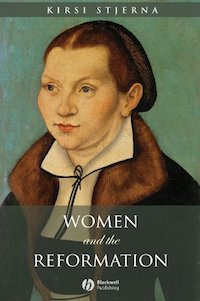According to Luther, baptism made all Christians priests and enabled them to understand the Holy Scriptures. However, according to Luther, the preaching and baptism of women should be reserved for mere emergency situations. Although especially the consciousness of the priesthood of all the baptized had potential for the priesthood of women. In general, Luther has enhanced the status of the laity with his reformatory writings and has established a position opposed to the prevailing hierarchical structure within the church..[1]
cornelia schlarb
There are less and less doubts about the enormous importance of the participation, at all levels, of women in the reform movements of the 16th century. Critical studies have strongly questioned the lack of interest in the role played by many of them and the strong masculine flavor that most approaches to Protestant reforms reveal.. This is how, for example, Karin Stetina puts it:
Approximately half of the world is made up of women. Books like Half the Sky (Nicholas Kristof and Sheryl WuDunn) and Half the Church (Carolyn Custis James) highlight how important it is for the evangelical church to consider God’s vision both locally and globally for women. In light of the Gospel, the church during the Reformation also struggled with the place of women in the church, marriage, and society. While the Protestant Reformers did not set out to define the roles of women, in developing their theological convictions of sola Scriptura and the priesthood of all believers, they were faced with addressing the question of how women should participate in the church and the world. both as receivers and transmitters of the Gospel. Did the reformers’ responses result in “constraining” women by moving their ministry from the convent to the home (as Jane Dempsey Douglass argues), or did it provide them with a “new dignity” (as Stephen Nichols suggests)? The answer to that question is complicated.[2]
Written analyzes by scholars have had to emerge in order to renew the perspective on the female presence in these reforms. If in other times more attention was paid to the wives of the reformers or to noblewomen, in recent times the range has been widened and there is now a great consensus about how there was a great performance of women in all aspects of the religious and spiritual transformation that shook Europe in the 16th and subsequent centuries. A pioneer in these studies was Roland H. Bainton, legendary author of a biography of Luther and other obligatory references, with his trilogy Women of the Reformation 1971-1977), in which he dealt with those who participated in the movements in Germany, Denmark, Spain, France, Hungary, and Transylvania, England, Italy, Norway, Poland, Portugal and Sweden.
As a continuation of this path of research, Dr. Kirsi I. Stjerna, of Finnish origin, professor at the California Lutheran University Seminary, announced Women and the Reformation in 2009, a volume in which he studies the life and work of nine characters directly involved in the struggle for religious change and who are the best known: Katharina von Bora, wife of Luther; Argula von Grumbach; Elizabeth von Brandenburg; Elizabeth von Braunschweig; Katharina Schütz Zell, in the German-speaking world; Marie Dentiere; Margarita de Navarra, Jeanne d’Albret, Renata de Francia, in the francophone environment; and the Italian Olimpia Fulvia Morata.
All of these names appeared in Bainton’s books, but the way in which Stjerna delved into them is quite remarkable, since she faithfully studies them in their context after a highly thoughtful first part (“Choices and Visions for Women”) in the which breaks down four controversial aspects: their character as prophets, visionaries and martyrs; the monastic option: the struggle of the convents; marriage and motherhood: the preferred vocation; and learning and power, an elusive option. All this worked through very specific examples.
Prior to this publication, she defended her doctoral thesis at Boston University in 1995, entitled: “Saint Birgitta of Sweden: A Study of Her Spiritual Visions and the Theology of Love.” She has published several studies, including: “No Greater Jewel”: Thinking of Baptism with Luther (2009), Martin Luther, the Bible, and the Jewish People (2012, with Brooks Schramm), On the Apocalyptic and Human Agency: Conversations with Augustine of Hippo and Martin Luther (2014, ed. with Deanna A. Thompson), The Annotated Luther, I-VI vols. (2015-2017), Encounters with Luther: New Directions for Critical Studies (2016, ed. with Brooks Schramm), Martin Luther. A Christian between Reforms and Modernity (1517-2017) (2017), By Heart: Conversations with Martin Luther’s Small Catechism (2017, various authors), Y Lutheran Theology: A Grammar of Faith (2021). His articles and essays on related topics are innumerable (see here).
These days, just released Women Reformers in the Early Modern Europe: Profiles, Texts, and Contexts (Women reformers of early modern Europe: profiles, texts and contexts, Fortress Press), a large volume of 395 pages for which he coordinated more than 30 authors focused on dealing with the issue raised in eight sections:
I. Women theologians and the printed world
II. German women leading the reforms
III. English Women for the Protestant Faith
IV. French and Italian women for reforms
V. Dutch, Swiss and Anabaptist Women for Reforms
SAW. Protestant women and their Bible
VII. Protestant teaching and women’s agency
VII. Women negotiating reforms in different contexts and spaces
In each one, three or four specialists intervene, among whom we can mention Elsie McKee (“Katharine Schütz-Zell (1498-1562): passionate mother of the church”), Mary B. McKinley (“Marie Dentière (1495- 1561): in defense of women”), Gianmarco Braghi (“Olimpia Fulvia Morata: magistrate eloquent”), Päivi Räisänen-Schröder (“Anna Scharnschlager and Margarita Endris: Anabaptist women and their letters”), Rebecca Giselbrecht (“Being Reformed: Women in the Zurich Reformation”), G. Sujin Pak (“Argula von Grumbach and Katherine Schütz-Zell as Biblical Interpreters”), Merry E. Wiesner-Hanks (“Marriage in Protestant Europe”), Austra Reinis (“Thistles and Thorns: Women Resisting the Reformation”), Marjorie Elizabeth Plummer (“ Anna Jacobäa Fuggerin and the convent of Saint Katharina in Augsburg: the end of a simultaneous experiment”), Raisa María Toivo (“Katarina Jagiellon (1526-1583): a queen negotiating the Reformation in the north”), Eleonora Belligni (“The Via Italiana: Women, Religion, and Society During the Age of the Reformation”) and Jonathan A. Reid (“’Without Women or Children’: Without Reformation in France”).
The note announcing the publication reads:
Most of the women in the book left a written record, providing a valuable window into women’s spirituality and theology. Gender issues are addressed throughout the chapters providing irrefutable evidence of the essential roles of women in the reception and implementation of the Protestant confessions. An important voice comes from women who defended their right to participate in the Catholic faith. […]
The tone of the volume is scholarly, but it invites a broad spectrum of readers who have varying levels of background knowledge. It is particularly suitable as a textbook or reference guide in different disciplines (Reformation studies, church history, theological history, gender studies, early modern and 16th century studies, and languages) (Consult here).
 The preface alludes to Bainton’s books published by the same publisher. The book opens with an introduction entitled: “Expanding the horizons with women at the center” (“Expanding the horizons with women in the center”), where the editor (who also writes about the printer Margarita Prüss [-1542]) summarizes the purposes of the work and points to its objective: “Women were an integral part of that tumultuous landscape of European transformations in the 16th century. Whether they received, defended, transmitted, applied—or even rejected—the teachings of the Reformation in early modern Europe, the participating women provide a compelling perspective on the many twists and turns of the larger story. History is not homogeneous”.
The preface alludes to Bainton’s books published by the same publisher. The book opens with an introduction entitled: “Expanding the horizons with women at the center” (“Expanding the horizons with women in the center”), where the editor (who also writes about the printer Margarita Prüss [-1542]) summarizes the purposes of the work and points to its objective: “Women were an integral part of that tumultuous landscape of European transformations in the 16th century. Whether they received, defended, transmitted, applied—or even rejected—the teachings of the Reformation in early modern Europe, the participating women provide a compelling perspective on the many twists and turns of the larger story. History is not homogeneous”.
Immediately after recognizes the role played by the most mentioned women and points out that, from their particular situation, each of the people studied developed their own vision of the Reform that contributed to its more complete and diverse articulation, whether as nuns, wives, writers or hymn writers. In particular, Stjerna refers to those who, without biblical or theological training, “published their theologies and produced theological texts (such as Susanna and Cornelia Teellinck and Elisabeth Tyrwhit), and tried to equip their Christian brethren and Protestant communities with new words, songs and prayers (Katharina Schütz Zell and Elisabeth Cruciger)”. She concludes by saying, “This book invites the reader to engage with reforming women.”
With this issue, 700 collaborations in Evangelical Digital are completed.
We hope to continue with the favor of our readers. Thanks.
Grades
[1] C. Schlarb, “Women in the Reformation Period Female reformers – Reformers’ wives – Women who acted for reformation”, see here. Own version.
[2] K. Stetina, “What the Reformation did and didn’t do for Women?”, in Biola University, see here. Own version.
Published in: DIGITAL Evangelical – Living Geneva
– “Reformed Women in Early Modern Europe”, edited by Kirsi I. Stjerna
“Reformed Women in Early Modern Europe”, edited by Kirsi I. Stjerna

